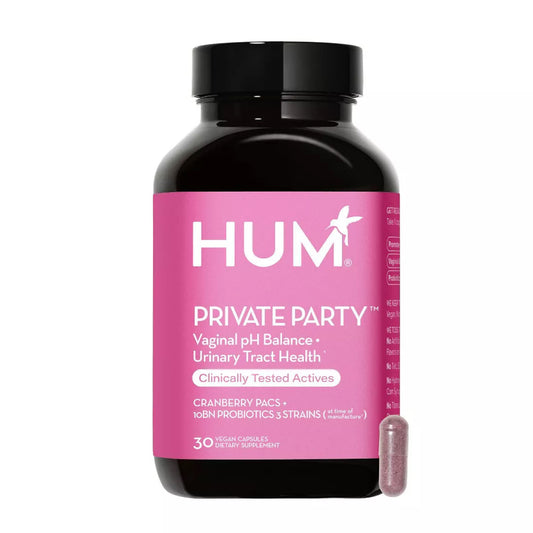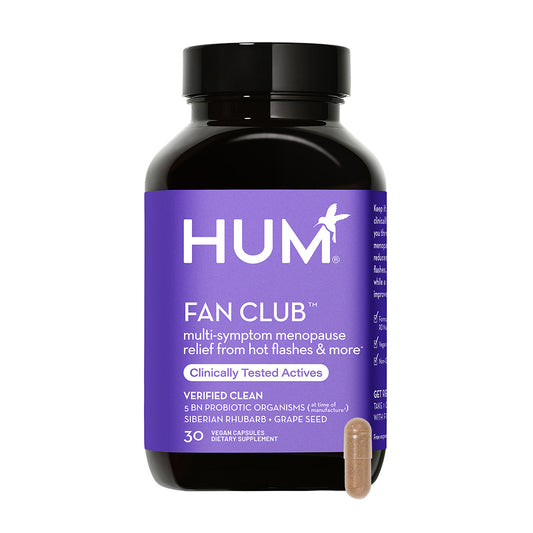Paying attention to your sexual health is just as important as your mental health and the rest of your physical health. And this includes 2 common menopausal symptoms — vaginal dryness and painful sex. These might be hard to talk (or read) about. But when you learn ways to provide relief, you may be glad you did.
What is vaginal dryness?
Just so we’re all on the same page, the diagram below shows the female reproductive system and exactly which part the vagina is.

Ok, now that we’re all talking about the same thing, let’s talk about vaginal dryness. This is a common symptom during perimenopause, menopause, and postmenopause. Up to 85% of women ages 55-65 have reported experiencing vaginal dryness. You may also see vaginal dryness talked about using its medical term — genitourinary syndrome of menopause (GSM).
In addition, the decrease in estrogen can limit the body’s natural production of lubrication by impacting the lubricant-producing glands near the entrance to the vagina, reducing blood flow to the clitoris and vaginal tissues, and the amount of cervical discharge. So, during menopause, your tissues are not only thinner and less flexible, but your body also produces less lubrication than it did before, further complicating sexual function during postmenopause.
Vaginal dryness can lead to some uncomfortable symptoms including:
- Feeling pain with penetrative sex.
- Burning or itching.
- Abnormal discharge.
This discomfort can cause some people to avoid intimacy, experience a decreased sex drive, or experience painful sex.
What is painful sex?
Painful sex, also known as dyspareunia, can be a result of vaginal dryness, but it can also be caused by, but is not limited to, other factors such as vaginal infections, endometriosis, or pelvic floor muscle dysfunction. It can be difficult to understand the cause on your own, so it’s important to see a healthcare professional to determine the cause of painful sex and to develop an appropriate treatment plan.

How to treat vaginal dryness
It’s important to talk to a healthcare professional if you’re experiencing vaginal dryness and painful sex. A healthcare professional can help determine the cause of these symptoms and provide appropriate treatment options. With proper care, you can continue to enjoy sex during menopause.
Prescription treatments
If menopause is the cause of your vaginal dryness, a doctor or a telemedicine provider may recommend low-dose vaginal estrogen therapy, which is a form of menopause hormone therapy. It can come in the form of a cream, tablet, capsule, or vaginal ring which allows a small amount of estrogen to be absorbed into the bloodstream.
When used regularly, low-dose vaginal estrogen therapy can help restore the topmost layer of vaginal cells and increase skin elasticity. It might give it away by the name, but these forms of low-dose estrogen therapy provide a lower dose of hormones to your body compared to a pill or patch. These treatments are also temporary in the sense that as soon as you stop the treatment, your symptoms (vaginal dryness) can return.
The FDA has also approved 2 non-estrogen medications — ospemifene (oral medication) and prasterone (vaginal tablet) — to help treat severe cases of painful sex that are caused by vaginal changes during menopause.
Prasterone (also known as DHEA (dehydropiandrosterone)) turns into estrogen and testosterone when the tablet is placed in the vagina. Ospemifene is not estrogen, but in vaginal tissue, it acts very similar to estrogen because it binds to estrogen receptors and signals to those cells in a similar way to estrogen.
These are treatments that must be prescribed by a doctor. Ask your doctor about the risks and benefits and whether they are right for you.
Over-the-counter treatments
Treatment for vaginal dryness and painful sex that you can get without a prescription include vaginal moisturizers and water-based or silicone-based lubricants. They provide temporary relief from vaginal dryness and discomfort.
- Lubricants. Designed to reduce friction and discomfort from dryness during sexual intercourse. They can be applied right before sex.
- Moisturizers. They're applied inside the vagina (as a gel or suppository) about 3 times a week to help provide a continuous moisturizing effect. They contain hyaluronic acid, which helps the vaginal tissues to retain moisture more effectively. Do not use hand or body moisturizers or lotions since they can easily irritate the vaginal tissues.

Pelvic health physical therapy
Pelvic floor physical therapy is another valuable resource for addressing the unique challenges of menopause. It can easily complement other treatment options. Through education, a therapeutic exercise plan, and lifestyle changes, pelvic physical therapy can help you improve the strength, flexibility, and coordination of your pelvic floor. This can significantly improve your sexual function. For example, pelvic physical therapy can:
- Increase the blood flow to your pelvic muscles, connective tissues, and erogenous tissues to increase arousal.
- Increase tissue flexibility and the strength of pelvic floor muscles to improve sensation during vaginal penetration, and support orgasm.
- Release pelvic floor muscle tension, and help your body relearn that touch and stretch to your vulva and vagina does not have to be painful.
- Help you find better positions to use during sex which minimize strain and pain in your joints, muscles, and vaginal tissues.
If you’re experiencing vaginal dryness or other pelvic floor symptoms, reaching out to a pelvic floor physical therapist or your physician could be an important step in finding relief.
Masturbation
Self-pleasure, with or without sex toys, can help keep blood flow to the genitals, which may help with symptoms of GSM.
Other options to help provide relief
Other options to relieve symptoms include lifestyle changes such as:
- Drinking more water. This helps maintain overall moisture levels in the body.
- Avoiding irritants and perfumed products. This can include perfumed powders, soaps, and bubble baths. They can be irritating to the vagina.
- If it’s not painful, continue to have sex as it can help keep the vaginal tissues soft and elastic.
- Outercourse (sexual activity that doesn’t involve penetration) and other forms of intimacy. While you’re looking for what form of treatment works for you, or having trouble finding treatment that helps, talk to your partner about other ways you can be intimate.
References
Angelou, K., Grigoriadis, T., Diakosavvas, M., Zacharakis, D., & Athanasiou, S. (2020). The genitourinary syndrome of menopause: An overview of the recent data. Cureus, 12(4): e7586. doi: 10.7759/cureus.7586.
Bachmann, G. & Pinkerton, J.V. (2022). Patient education: Vaginal dryness (Beyond the basics). UpToDate. Accessed 3/29/23 from https://www.uptodate.com/contents/vaginal-dryness-beyond-the-basics
Endocrine Society. (2022). Reproductive hormones. Accessed 3/29/23 from https://www.endocrine.org/patient-engagement/endocrine-library/hormones-and-endocrine-function/reproductive-hormones
Grimes, W.R. & Stratton, M. (2022). Pelvic floor dysfunction. StatPearls [Internet]. Accessed 4/12/23 from https://www.ncbi.nlm.nih.gov/books/NBK559246/
Levin, R. & Riley, A. (2007). The physiology of human sexual function. Psychiatry, 6(3): 90-94. https://doi.org/10.1016/j.mppsy.2007.01.004
MedicalNewsToday. (2018). Natural remedies for vaginal atrophy. Accessed 3/29/23 from https://www.medicalnewstoday.com/articles/315089
MedicalNewsToday. (2019). Why is my vagina wet? Accessed 3/29/23 from https://www.medicalnewstoday.com/articles/326504
Mercier, J., Morin, M., Zaki, D., Reichetzer, B., Lemieux, M-C., Khalifé, S., & Dumoulin, C. (2019). Pelvic floor muscle training as a treatment for genitourinary syndrome of menopause: A single-arm feasibility study. Maturitas, 125: 57-62. doi: 10.1016/j.maturitas.2019.03.002.
National Institute on Aging. (2021). Sex and menopause: Treatment for symptoms. Accessed 3/29/23 from https://www.nia.nih.gov/health/sex-and-menopause-treatment-symptoms
Naumova, I. & Castelo-Branco, C. (2018). Current treatment options for postmenopausal vaginal atrophy. International Journal of Womens Health, 10: 387-395. doi: 10.2147/IJWH.S158913
Rochera, M. (2016). Physiotherapy in treating sexual pain disorders in women: A systematic review. Advances in Sexual Medicine, 6, 26-32. doi: 10.4236/asm.2016.63004.
Sartori, D.V.B., Kawano, P.R., Yamamoto, H.A., Guerra, R., Pajolli, P.R., & Amaro, J.L. (2021). Pelvic floor muscle strength is correlated with sexual function. Investig Clin Urol, 62(1): 79-84. doi: 10.4111/icu.20190248.
Simon, J.A., Kokot-Kierepa, M., Goldstein, J., & Nappi, R.E. (2013). Vaginal health in the United States: Results from the Vaginal Health: Insights, Views & Attitudes survey. Menopause, 20(10): 1043-1048. doi: 10.1097/GME.0b013e318287342d.
Simon, J.A., Nappi, R.E., Kingsberg, S.A., Maamari, R., & Brown, V. (2014). Clarifying vaginal atrophy’s impact on sex and relationships (CLOSER) survey: Emotional and physical impact of vaginal discomfort on North American postmenopausal women and their partners. Menopause, 21(2): 137-142. DOI: 10.1097/GME.0b013e318295236f
Sobel JD, Barbieri RL, Eckler K. (2023). Patient education: Vaginal discharge in adult women (Beyond the Basics). UpToDate. Accessed 4/13/2023 from https://www.uptodate.com/contents/vaginal-discharge-in-adult-women-beyond-the-basics
The LibreTexts Libraries. (2023). Blood flow in skeletal muscle. Accessed 4/20/23 from https://med.libretexts.org/Bookshelves/Anatomy_and_Physiology/Anatomy_and_Physiology_(Boundless)/18%3A_Cardiovascular_System%3A_Blood_Vessels/18.7%3A_Blood_Flow_Through_the_Body/18.7C%3A_Blood_Flow_in_Skeletal_Muscle
Waetjen, L.E., Crawford, S.L., Chang, P-Y., Reed, B.D., Hess, R., Avis, N.E., Harlow, S.D., Greendale, G.A., Dugan, S.A., & Gold, E.B. (2018). Factors associated with developing vaginal dryness in women transitioning through menopause: A longitudinal study. Menopause, 25(10): 1094-1104. doi: 10.1097/GME.0000000000001130
Wallace, S.L., Miller, L.D., & Mishra, K. (2019). Pelvic floor physical therapy in the treatment of pelvic floor dysfunction in women. Curr Opin Obstet Gynecol, 31(6): 485-493. doi: 10.1097/GCO.0000000000000584.








4 comments
I’m 56 years old been a widow for 11 years and got with a guy friend IV known for 25 years but I have bad vaginal dryness and I don’t seem to feel horny like I did with him what can I do to help us both.
How lomg does it take to stop or relieve the pain in having sex
I really need to know why does it hurt when I wipe myself it’s feels like I cut myself down there ?? Please help
I need this because my vaginal is dry and it hurt to have sex with my husband